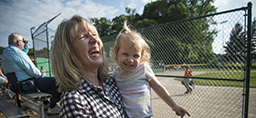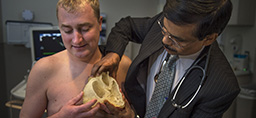
Heart defects are the most common birth defects, but some cases are the rarest of all.
Anthony Vitale had one of the rare ones.
He spent the first three months of his life in a NICU, before having surgery to put a band around his pulmonary artery.
At 9 months, Anthony had his second surgery to bypass venous blood around the heart directly to the pulmonary arteries.
Anthony’s problem proved to be so complex that, despite having one chamber, doctors at the time decided he should have a simple, partial repair to stabilize him. The work needed inside the heart was too complex for a full repair.
While the surgeries helped, his blood oxygen level remained constantly low. Anthony couldn’t play like other toddlers and became increasingly blue because of complications in his lungs.
Anthony’s parents, Megan and AJ Vitale, knew a heart transplant wasn’t an option because of his unique heart composition. Yet he needed help in order to live a long, healthy life.
They debated about going back to the east side of the state where Anthony’s first two surgeries had taken place, but had heard from other parents through Mended Little Hearts of West Michigan about the Spectrum Health Helen DeVos Children’s Hospital Congenital Heart Center and the expertise available.
They met with Joseph Vettukattil, MD, chief of pediatric cardiology, who demonstrated the intra-cardiac anatomy through a cardiac MRI so congenital heart surgeon Marcus Haw, MS, FRCS, could review Anthony’s condition.
Together, they decided a corrective surgery would be possible by doing a complete heart reconstruction, something only a few congenital heart patients have. It would be a 4- to 8-hour surgery, in which Dr. Haw would restructure Anthony’s heart to work as a two-chamber heart.
Depending on how it went, Anthony might need a second surgery immediately following it.
“Allowing Anthony’s heart to work as a two-chamber heart in comparison to the previous single chamber heart gives him a much better chance for a long, healthy life than would ever be possible with a single ventricle repair,” Dr. Haw said.
“Dr. Haw gave us the risks without scaring us. He has done approximately 10 similar surgeries and the odds were good for Anthony,” Megan said. “Until then I didn’t know how severe it was. That almost no one has his exact plumbing.”
The Vitales decided to have the surgery at Helen DeVos Children’s Hospital and scheduled it for early September 2014. They tried to prepare 3-year-old Anthony as much as possible.
“We told Anthony he was going to get a new zipper on his chest,” Megan said. “We called it his ‘fix it’ day and made a countdown chart.”
‘Fix it’ day came: Sept. 3. While the Vitales waited and worried, the Congenital Heart Center surgical team led by Dr. Haw worked on Anthony’s heart. The heart reconstruction ended up taking 12 hours.
It was successful.
Road to recovery
“Because Anthony had a very severe lack of oxygen in his blood prior to surgery, we were very aware that this would only resolve after several weeks of the new circulation,” Dr. Haw said. “The intensive care unit worked together to support Anthony through a long post-operative recovery.”
Anthony’s heart now beat a strong rhythm.
Anthony remained sedated for several weeks after the surgery and experienced some complications, including an infection in his lungs, blood clots in his leg and arm, asthma and sleep apnea.
He lost muscle memory due to the length of sedation, so he had to relearn how to walk. Due to a tracheostomy, he couldn’t talk, which made communication a challenge until they started using a pointer laser.
Through physical, occupational and speech therapy in the hospital, Anthony gradually relearned the skills.
“I remember when they put the speaking cap on his trach so he could talk and he said, ‘Hi, Mama.’ I started crying,” Megan said. “I didn’t realize how much I had missed the sound of his voice.”
Newfound energy
For the first time, Anthony has energy to play. He’s doing what other 4-year-old kids do with a big smile on his face.
“The really cool thing about this operation is that the complications that occurred in the lungs have completely resolved now that the plumbing has been put back to normal, giving Anthony the best change for the future,” Dr. Haw said.
Anthony takes some medication and uses an inhaler during the day for asthma. At night, he sleeps with oxygen for sleep apnea.
He visits the Congenital Heart Center for check-ups and may need minor intervention or surgery in the future, but the most difficult part is over.
Reflecting on how far Anthony has come, Megan shared, “It’s been a journey, with lots of ups and downs. I don’t think we could have done it without all the support and people cheering Anthony and us on.”

 /a>
/a>
 /a>
/a>
 /a>
/a>